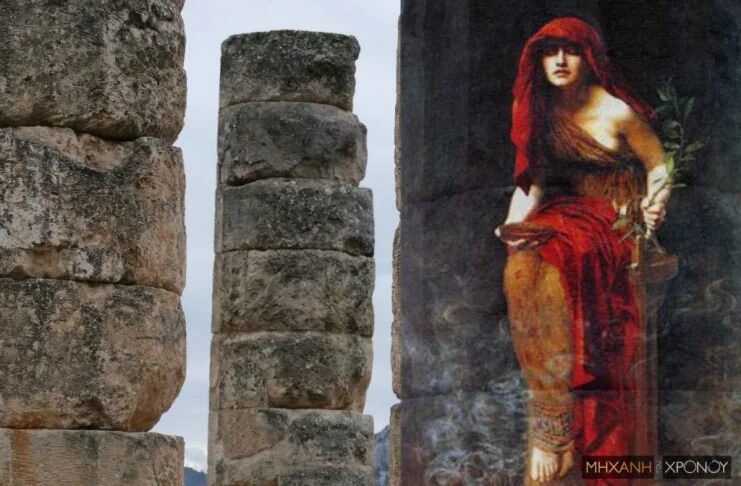"Pythia" was the title given to every high priestess of the god Apollo who was raised to devote her life to his service. Originally they were all young girls and virgins.
However, the forbidden love of Echekratis of Thessaly, who went to fetch an oracle and kidnapped the high priest, changed the facts. From that event on, "Pythias" had to be middle-aged women and usually married with a family. The word "Pythia" comes from the ancient verb "πυνθάνομαι", which means "to be informed". A second version wants to come from "Python", the name of a reptile, a snake or a "dragon" which, according to mythology, was killed by Apollo to conquer the oracle of Delphi.
During her tenure, she lived inside the temple. She wore a white tunic and lived by strict rules set by the priests. There were no special conditions for a woman to be chosen, nor did she have to have divination abilities. In the beginning, there was only one. As the oracle's fame grew, the Pythias became three. According to Greek Mythology, the first oracle of Delphi was Fimonoi. Access to the oracle was free to any believer who truly needed the oracle. Women were strictly forbidden to enter, but they could ask their questions to the high priest through a representative. The type of divination that the Delphic oracle used, was the "entheos". This means that through the Pythia, the faithful believed they were hearing the god Apollo. They initially gave oracles 9 times a year, except during the three months of winter when Apollo traveled to the "Hyperborea" and his brother Dionysus took over.
The Oracle offering
To receive the oracle, the faithful had to leave before the oracle entered. A round cake of flour, oil and honey was offered to the gods, along with the animals each visitor brought for the same purpose. Their questions were revealed to the priests in advance, while immediately afterward the order in which they would enter the sanctuary was drawn by lot. After purifying themselves in Castalia spring, they went to the sanctuary of the oracle and placed themselves where they could not see her.
"Know thyself"
In the time of the oracle, Pythia, in order to give her oracle, had to chew laurel leaves after she had purified herself in Castalia spring. According to the ancients, there was a crevice in the sanctuary from which gushed a spring of strange vapors and strong odor. This plunged them into a kind of ecstasy. Usually, the first sentences were reminiscent of inarticulate cries. The oracles were laconic(few words) and often unintelligible. The difficulty of the problem for which he had to give an oracle always played an important part. The task of the priest was to decipher what was said and to convey it to the person interested. That is why there was a warning sign in front of the oracle with the inscription "Know thyself". Everyone had to know well what he wanted to know.
The scientific explanation
In the spring of 1892, the village of Kastri built directly above the archeological site, hid the answer. The French archeological school bought all the houses in the village and demolished them. The foundations of the temple were found in the cellars of the houses. In 1894, excavations began inside the sanctuary. But the place was constantly filled with water. In 1913, archeologists managed to penetrate the rocky subsoil. They were waiting to find a large crack in the rock from which intoxicating vapors would escape. They were also waiting to find the source inside the temple. All they finally found was a dirty floor. The news spread and grew as the old reports were disproved and there was now a great schism.
The Oracle of Delphi passed into the realm of mythology. Nearly 100 years later, geologist Gele de Burg reviewed the reports and discovered an omitted object. Most archeologists believed they would find a large cavity under the temple. The geologist, along with specialized scientists, proceeded to analyze the soil and water elements of the area. The results shook the scientific world and laid a new foundation for research.
In the 1980s, as part of another job he was doing in the field for the Greek government, the geologist accidentally discovered the beginning of a trench. He had to walk for miles to follow its trail. He then compared the findings with satellite images, which confirmed his suspicions. It was clear that the trench continued eastward toward Corinth below the village of Delphi. This revived theories about "intoxicating gas" that had been discarded after excavations at the sanctuary in 1913. But according to researcher Steven Soter, the secretion of such gasses is as common today as it was 2,000 years ago. It was confirmed that the entire area was exposed to gas emissions from faults associated with earthquakes. Underwater craters were found on the seabed, which was clear evidence that gasses were emitted from the seabed. From a geological point of view, gases are usually associated with volcanic areas. The large crack helped them rise from the bottom to the surface.
Source: mixanitouxronou









